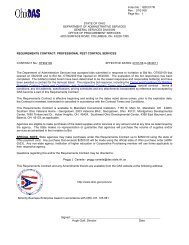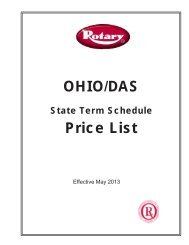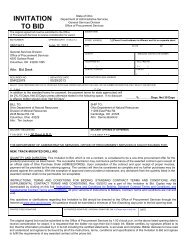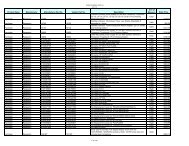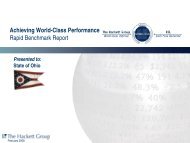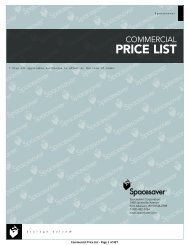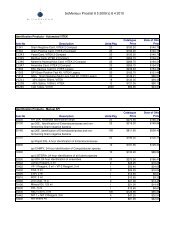Annual Opportunity Sizing - State Procurement - State of Ohio
Annual Opportunity Sizing - State Procurement - State of Ohio
Annual Opportunity Sizing - State Procurement - State of Ohio
You also want an ePaper? Increase the reach of your titles
YUMPU automatically turns print PDFs into web optimized ePapers that Google loves.
<strong>Ohio</strong> Department <strong>of</strong> Administrative Services<br />
Ted Strickland, Governor<br />
Hugh Quill, Director<br />
C. Minority Business Enterprise (MBE) Set Aside Competition<br />
Service, Support, Solutions for <strong>Ohio</strong> Government<br />
DAS Directive<br />
Directive No. 09-21<br />
Effective Date: 09-01-08<br />
When using direct purchasing authority, state agencies are required to select a number <strong>of</strong><br />
purchases, the aggregate value <strong>of</strong> which equals approximately 15% percent <strong>of</strong> their total<br />
purchases <strong>of</strong> supplies and services for the fiscal year, for competition by MBEs only. When<br />
exercising direct purchasing authority, remember to definitively mark all purchasing documents to<br />
show only MBE vendors were contacted for price quotes. Also, monitor set asides quarterly and<br />
adjust your projections and selections as necessary. Agency purchases from DAS term contracts<br />
that have been set aside may be considered in their 15% percent goal.<br />
It is important to evaluate the impact <strong>of</strong> your set aside selections. For each contract to be set<br />
aside, consider the following:<br />
1. All product/service categories may not have certified MBEs available to compete for the<br />
need. Check the listing <strong>of</strong> certified MBEs maintained by the DAS Equal <strong>Opportunity</strong> Division<br />
(EOD) prior to selecting the item for set aside.<br />
2. Do not repeatedly select an entire product category for set aside (e.g., all <strong>of</strong> the contracts for<br />
the purchase <strong>of</strong> shoes, etc.). Consider various categories <strong>of</strong> products/services and then<br />
alternate setting them aside.<br />
3. Do consider contract incumbency or longevity (e.g., who has held the contract for the last 10<br />
years) and its impact on both minority and majority firms.<br />
4. Consider dividing contracts or purchases into smaller contracts or multiple contracts in order<br />
to allow small businesses to compete.<br />
D. EDGE Purchases<br />
Agencies are required to participate in a contract assistance program called the Encouraging<br />
Diversity, Growth, and Equity Program (EDGE). EDGE establishes procurement goals by<br />
comparing contractor availability to contractor utilization and eligible expenditures. The initial<br />
goal is to award 5% percent <strong>of</strong> all contracts for supplies, services, information technology, and<br />
construction to EDGE participants.<br />
EDGE further requires every cabinet-level state agency, within the constraints <strong>of</strong> statutory<br />
authority and as otherwise provided by law, to:<br />
1. Take appropriate steps to foster, support and encourage the participation <strong>of</strong> underutilized<br />
businesses and encourage such businesses to compete for construction contracts and the<br />
procurement <strong>of</strong> goods and services by including a participation goal for construction<br />
contracts and requests for proposals when subcontractors or sub-consultants are used.<br />
5




